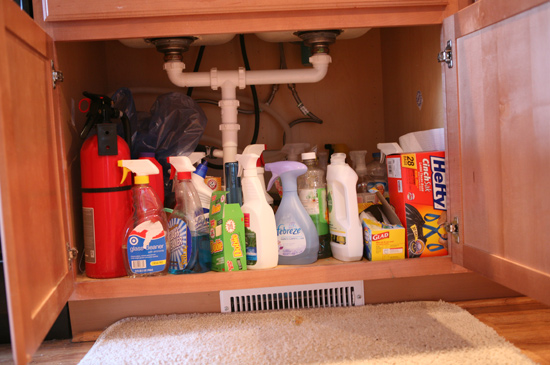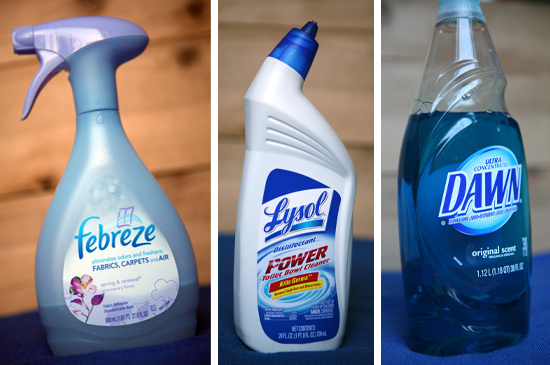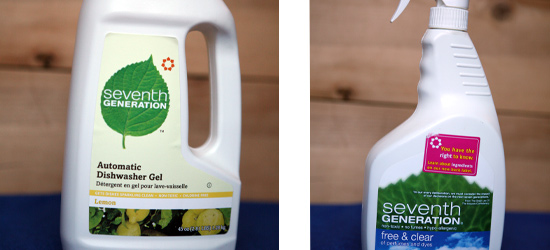It’s that time of the year when the wind-chill likes to lurk somewhere around 25 degrees below zero in northern Minnesota. It’s also that time of year when you hear yourself saying “why do I live here again?” a couple times a day.
Perhaps because we’re indoors more in the winter, I have begun to notice all the little things that bug me about our house. For example, the cabinet under our kitchen sink is full to the gills with half-empty (or half-full?) bottles of cleaning agents. Windex, Febreze, Mr. Clean, etc. The whole gang’s there.
It seems that we have a nasty habit of buying a new bottle before the old one’s totally used up.
 But our over-zealous purchasing of cleaning liquids isn’t the only issue here…
But our over-zealous purchasing of cleaning liquids isn’t the only issue here…
The really irksome part of it is that only half of the products in our cabinet are environmentally safe, let alone safe for humans to be absorbing. It was only about a year ago that we started making an honest effort to buy only “green” household products, so many of the “not so green” ones are still sitting around, half-empty.

These “not so green” cleaners contain toxins that leech into our water system, getting ingested by wildlife and people. {Read more about the effects of these chemicals on the environment here.} The scariest chemicals are the ones that effect human and animal endocrine systems, because they imitate hormones and cause irreversible damage.
In reference to endocrine disrupting chemicals, the National Resources Defense Council’s website says,
Many animal species are showing signs of ill health due to exposure to endocrine disrupting chemicals. For example, fish in the Great Lakes…have numerous reproductive problems as well as abnormal swelling of the thyroid glands.”
In some cases, the fishes capacity to reproduce was eliminated, as they became feminized by the amount of estrogen-imitating chemicals in the water. {Read more about that here.}
Yesterday I put my foot down and decided it was time to rid our home of these awful products.
I got a big surprise as I opened the cabinet door: I looked at my bottle of Lysol toilet cleaner, expecting to see a nice long list of big words I can’t pronounce (i.e. ingredients). But there was nothing but a big long list of cautionary alerts about not eating it or rubbing it into your eyes. Hmmmmm!
Turns out cleaning supply manufacturers are not required to list their ingredients on their bottles. Some {like Febreze and Dawn} only list certain ingredients on the bottle, and conceal others. {More about Dawn’s attempt to come across as a “green” product here.}
A few big questions were arising at this point, so I turned to the power of Google for some answers:
![]() Which products contain harmful chemicals?
Which products contain harmful chemicals?
Too many. The most common include commercial laundry detergent, especially those with added fragrances, dryer sheets and commercial fabric softener, drain cleaners, pesticides, herbicides, anti-bacterial ANYTHING, potpourri, air fresheners, incense.
![]() What are the “bad” chemicals, so I can avoid them in the future?
What are the “bad” chemicals, so I can avoid them in the future?
| Ammonia | Fatal when swallowed |
| Ammonium Hydroxide | Corrosive, irritant |
| Bleach | Potentially fatal if ingested |
| Chlorine | Number one cause of poisonings in children |
| Formaldehyde | Highly toxic; known carcinogen |
| Hydrochloric acid | Corrosive, eye and skin irritant |
| Hydrochloric bleach | Eye, skin and respiratory tract irritant |
| Lye | Severe damage to stomach and esophagus if ingested |
| Naphtha | Depresses the central nervous system |
| Nitrobenzene | Causes skin discoloration, shallow breathing, vomiting, and death |
| Perchlorethylene | Damages liver, kidney, nervous system |
| Petroleum Distillates | Highly flammable; suspected carcinogen |
| Phenol | Extremely dangerous; suspected carcinogen; fatal taken internally |
| Propylene Glycol | Immunogen; main ingredient in antifreeze |
| Sodium hypochlorit | Potentially fatal |
| Sodium laurel sulfate | Carcinogen, toxin, genetic mutagen |
| Sodium tripolyphosphate | Irritant |
| Trichloroethane | Damages liver and kidneys |
![]() How do I dispose of these products?
How do I dispose of these products?
Many communities hold special collection days or have special drop-off sites for harmful household products. Contact your local trash service for help, call EARTH 911 (1-877-EARTH911), or visit www.earth911.org
In Duluth’s case, we have a hazardous waste disposal facility near our house, but we never knew it until a helpful neighbor told us about it! Thanks neighbor!
![]() Which products should I use instead?
Which products should I use instead?
Non-toxic, non-toxic, non-toxic.
Even “all-natural-plant-derived” ingredients can be toxic! Do research before buying a new product. Make sure that the super-duper-eco-licious cleaner actually holds up in court (uh, Google)- don’t just trust the commercials.

One brand I have investigated and have found to be as-good-as-it-gets: Seventh Generation. It’s slightly more expensive than its toxin-infested cousins, but really, the cost of using those other products is much, much greater.



